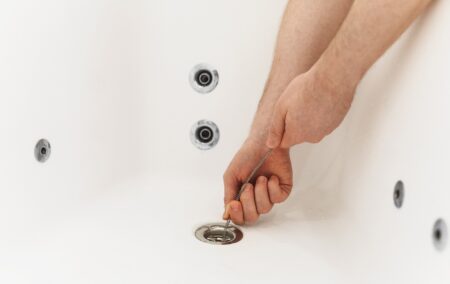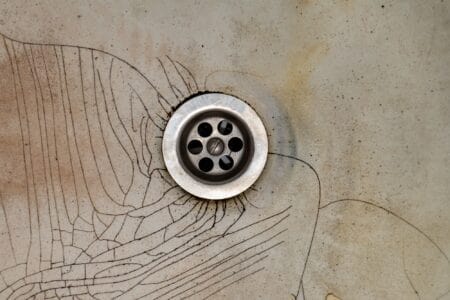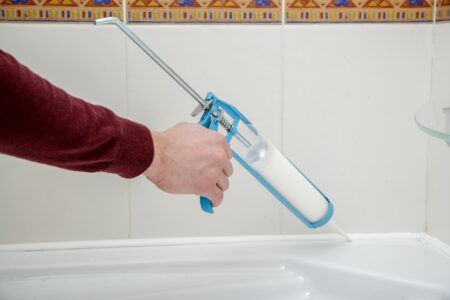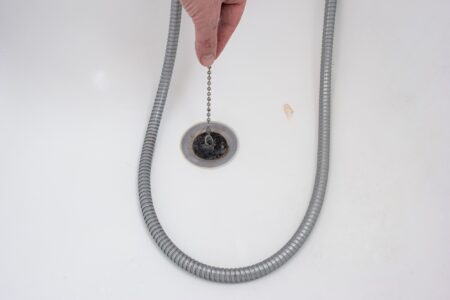A clogged tub drain is a real pain. If you’ve tried using a plunger and cleaning the drain stopper and still have a blockage, you’ll need another solution. Say hello to a drain snake!
We show you that snaking a tub drain is easier than you think, how to select the right drain snake for the task, and even make a homemade version.
Key Takeaways
- Select the right drain snake size: Choose a snake with a cable size of 0.25 to 0.31 inches for tub drains, and 0.31, 0.37, or 0.45 inches for shower drains.
- Access the drain via the overflow plate: Unscrew the overflow plate and feed the snake into the overflow tube instead of the plug hole to avoid damage.
- Activate the drain snake: Turn on the motor and keep feeding the cable into the pipe. If the cable starts to bend or kink, pull it out slightly and reinsert it back into the drain.
- Remove the snake and replace the overflow plate: Run the faucet to check if the water drains away. If it does, extract the snake and screw the plate back onto the bathtub.
What Size Snake for a Tub Drain?
Most tub drain pipes measure 1.5 to 2 inches in diameter, so you need a snake that fits snugly into that pipe. Look for a drain snake with a cable size of 0.25 to 0.31 inches.
If you unblock a shower drain, they have larger pipes to allow the water to flow away much faster. Most drain pipes measure 2 to 3 inches in diameter, so the drain snake should be 0.31, 0.37, or 0.45 inches in cable thickness.
Top Tip
Your drain snake must be thin enough to feed through the P-trap beneath your sink or tub.
How to Snake a Bathtub Drain
Snaking a tub is straightforward enough, but you’ll need some tools and equipment before you get down to work.
What You’ll Need
- Drain snake (motorized preferred).
- Screwdriver.
- Drop cloths.
- Gloves.
1. Protect the Bathtub
Lay your drop cloth onto the base of your bathtub. It protects your tub against scratches and gouges from the drain snake. Porcelain, ceramics, and plastic surfaces mark easily and can be tricky to remove.
2. Unscrew the Overflow Plate
Use the screwdriver and remove the screws from the overflow plate. You might be tempted to push the drain snake into the plug hole. Avoid doing this because the P-trap beneath the drain has a sharp bend and could get easily damaged.
You can access the drain with the plate removed via the overflow pipe.
Take Note
If your drain stopper operates via a lever, you must remove the linkage from the overflow pipe.
3. Feed the Snake
With the overflow plate removed, pop on your gloves and feed the auger end of the snake into the overflow tube. Feed it as far as it will go before reaching the blockage. You may need to wiggle the snake a little to get around the P-trap.
If you have a motorized snake, like this Populo Electric Drain Snake, only switch it on when the auger (snake’s tip) reaches the blockage.
4. Activate the Drain Snake
Turn on the motor and keep feeding the cable into the pipe. Keep the motor running slowly for the best results (it also ensures there is no damage to your plumbing). If the cable starts to bend or kink, pull it out slightly and reinsert it back into the drain.
Now stop the motor and pull the snake from the drain to check that you haven’t already hooked out the blockage.
Keep In Mind
Tub and toilet drains are often interlinked, especially if they are less than 10 feet from each other. Feeding the snake may send it up the toilet vent pipe. If that happens, withdraw the snake, crank the motor in reverse, and feed it in again.
The cable should find the correct pipe and clear the blockage.
5. Remove the Snake
Run the faucet and see if the water drains away. If it does, gently extract the snake by placing the motor in reverse. If you have a hand snake, like this Anti-Break 30-Inch Nylon Plumbing Snake, withdraw it by hand.
6. Replace the Overflow Plate
With the blockage gone, screw the plate back onto the bathtub with the screwdriver. Now remove the drop cloth, and you are ready to use the tub.
How Do You Make a Homemade Snake?
If you have a drain that’s not working because it’s full of hair, you could rush out and get a drain snake or make it from scratch. Adapting a metal coat hanger is an easy solution.
Untwist the ends of the hanger using pliers. Remember to wear safety gloves. Once the hanger ends are free, straighten it out so that the hanger looks like a long wire pole. It’s now ready to insert into your drain overflow.
Snake Won’t Go Down the Bathtub Drain
Sometimes, your snake refuses to budge, and no matter how hard you try, it won’t go down the drain. There are several reasons why:
P-Trap
The bend at the beginning of the drain pipe sometimes hampers the snake’s progress. Once you pass that point, it’s plain sailing, but you may need to wiggle the snake a little. This diagram shows the obstacles to a P-trap and why it could be the cause.
Pushing Too Fast
Work the drain snake slowly, or you risk the cable bending or kinking in the pipework. If that happens, you need to withdraw the snake and start again.
Not Twisting As You Push
If you have a manual snake, you must rotate it as you insert it into the drain. It helps the snake travel more easily and stops it from getting snagged.
FAQs
Final Thoughts
While unblocking a bathtub drain is less than glamorous, it is necessary from time to time. Knowing how to snake a tub drain helps to keep your drains flowing freely and saves you money in professional charges.
So, the next time you pull the plug and the water doesn’t drain, pop on your rubber gloves and grab that drain snake.









